Thanksgiving Turkey.
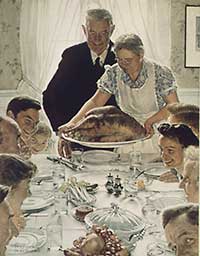
Turkey for Thanksgiving. It’s as American as motherhood and apple pie. Eighty-eight percent of Americans eat turkey on Thanksgiving.1 Many of us were taught that this is because the Pilgrims shared turkey with their Wampanoag neighbors at a Thanksgiving feast in 1621. Did they? And how did this annual ritual become a national institution?
The Plymouth Story. The story of turkey at the first Thanksgiving is largely based on tradition. There are only two known written accounts of that celebration. One says nothing about turkey and the other, written by Governor Bradford, was missing until long after the turkey tradition was well established.
Bradford lists fowl and game on the menu, and says the Wampanoag brought five deer. But there was plenty of time to eat, the feast lasted three days, so there could well have been turkey as well. Bradford says elsewhere that the Pilgrims hunted for turkey that autumn, and that may be where the traditional account comes from.
Turkeys are American. Regardless of whether turkey was served in Plymouth, they were domesticated in America long before the Pilgrims arrived. Indigenous people in Mexico and the Southwestern U.S. raised them for centuries. Montezuma’s Aztec court may have consumed 1,000 a day to feed both people and animals.
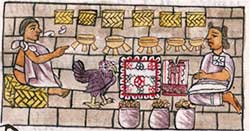
Early Spanish explorers took live turkeys back to Europe. This exotic foreign food was soon considered a delicacy and the Spanish king ordered ships returning from the New World to bring ten turkeys each, five male and five female, to increase the domestic supply.
Eventually turkey became popular in England. Early settlers, including the Pilgrims, brought turkeys with them to America. The turkeys we consume are probably descended from these birds and not the wild turkeys the settlers found when they arrived.
Thanksgiving Feasts. Thanksgivings began as special feasts held to express gratitude in good times. It took over 200 years for the American holiday to become an annual event. During that period, turkey became a staple of the New England diet. They were plentiful and tasty, fed lots of people, and unlike goats and cows were useful to people only as food. Thus, when Americans were starting to think of Thanksgiving as an annual holiday, turkey was viewed as a food native to the region where the first Thanksgiving dinner took place.
Turkey for Thanksgiving. Alexander Hamilton once said “no citizen of the U.S. shall refrain from turkey on Thanksgiving.”4 But it is Sarah Josepha Hale, the person who probably did more than anyone else to create the annual Thanksgiving holiday, who gave turkey its pride of place at the holiday table. In an 1827 novel, Northwood, she describes a New England family’s Thanksgiving dinner:
“The roasted turkey took precedence on this occasion, being placed at the head of the table; and well did it become its lordly station, sending forth the rich odor of its savory stuffing, and finely covered with the froth of the basting.”5
Hale was a very popular writer in her day, and her views carried a lot of weight, especially with women.
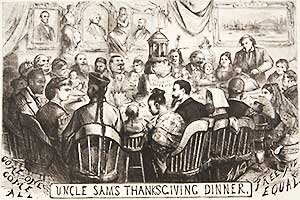
Charles Dickens is also credited with making turkey a dish for celebratory meals. Traditionally the English served duck and goose on holidays. But it is a turkey that Scrooge had delivered to Bob Cratchit’s house for Christmas dinner in Dickens’ A Christmas Carol. Dickens and A Christmas Carol were very popular and influential in nineteenth century America.7 His readings of A Christmas Carol in Boston and elsewhere in the U.S. were always popular.
As immigrants arrived, they added their own favorite foods to the table. But turkey remained at the center, and to many new arrivals enjoyment of this singularly American bird symbolized adoption of their new home’s traditions.
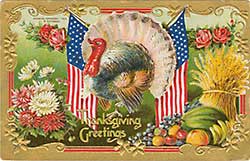
Turkey Tidbits. As with any cultural icon, there are many stories and legends surrounding turkeys. Here are a few.
Origin of the Name. There are probably more theories about the source of the name turkey than there are recommendations for cooking them. In the 1990s, for example, a debate raged on the pages of the New York Times about possible Hebrew origins.9
Many people assume from the name that the birds come from Turkey. They don’t. The birds sold in Turkey today are descended from the ones brought to Europe by the Spaniards and are called hindi.
But there may well be a different connection between the country and the bird. When turkeys were first brought to Europe, they were sometimes thought to be larger relatives of the guinea fowl, which were brought to Europe from Turkey. Moreover, Turkish traders controlled much of Mediterranean shipping in the 1500s, so many Europeans purchasing those birds may have been doing so from Turkish traders.10
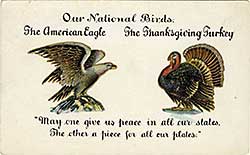
Our National Bird? Benjamin Franklin is sometimes said to have wanted to make the turkey the national bird. The story begins on July 4, 1776, when Congress appointed a committee to come up with a national symbol for the Great Seal of the United States. Numerous ideas were rejected until someone finally suggested a bald eagle.
Franklin did not approve. The eagle, he said, was an “animal of bad character,” noting in jest that the turkey was a “much more respectable bird.” It was also appropriate, he thought, that the national symbol be a uniquely American bird like the turkey. There is no evidence, however, that he ever intended his remarks to be taken seriously.12
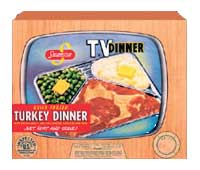
TV Dinners. Turkeys also gave us a staple of 1950s American cuisine, the TV dinner. In 1953, the Swanson company found itself with 260 tons of unsold frozen turkey. Salesman Gerry Thomas came up with the idea of selling prepackaged servings of turkey combined with a potato and vegetable, kind of like an airline meal at home. It was a big hit — 10 million meals were sold the first year and an industry was born.14
* * * * *
Thanksgiving is special. It is open to all and gives us an opportunity to reflect on blessings that sometimes go unnoticed. Whether you celebrate with turkey or tofu, may the holiday be a joyous one for you and yours.
-----
- See Turkey Facts at the University of Illinois Extension’s web site.
- Norman Rockwell, Freedom from Want (1943). Painting in the collection of the Norman Rockwell Museum. Image from Wikipedia. The painting is part of a series called The Four Freedoms. The Norman Rockwell Museum’s web site has an explanation of their World War II origin. The man and woman serving the turkey are Rockwell’s grandparents. For a fuller description of the scene by Rockwell’s granddaughter, Abigail, see The Saturday Evening Post (Nov. 21, 2014).
- Illustration is from Fray Bernardino de Sahagún, Historia general de las cosas de nueva España (General History of the Things of New Spain). Image from Wikipedia. For more information about this work see its entry in the World Digital Library.
- See, historical menus in Wikipedia article on Thanksgiving Dinner.
- Sarah Josepha Hale, Northwood, A Tale of New England, p. 109 Bowles & Dearborn, Boston (1827).
- Thomas Nast’s Uncle Sam’s Thanksgiving shows turkey being served to a diverse group of new Americans. The graphic appeared in Harper’s Weekly on November 20, 1869. Image from Hana Layson and Daniel Greene, Immigration and Citizenship in the United States, 1865-1924, on the web site of the Newberry Library.
- See Michelle Tsai, Why Do We Eat Turkey for Thanksgiving and Christmas, Slate.com (Nov. 21, 2007).
- Thanksgiving postcard published by Gottschalk, Dreyfuss & Davis (1909). In the collection of the New York Public Library, item 666597e0-c5c4-012f-4deb-58d385a7bc34.
- See, Zach Goldhammer, Why Americans Call Turkey “Turkey,” The Atlantic (Nov. 26, 2014).
- See, The Flight of the Turkey, The Economist (Dec. 17, 2014).
- Postcard created around 1900 showing eagle and turkey as national birds. Available on-line at Curt Teich Postcard Archive, Newberry Library.
- Emily Sneff, Unsullied by Falsehood: Ben Franklin and the Turkey, Course of Human Events (Declaration Resources Project Blog (Nov. 21, 2016).
- Package for Swanson Turkey TV Dinner. Image from Who “invented” the TV Dinner? at the Library of Congress web site.
- Owen Edwards, How 260 Tons of Thanksgiving Leftovers Gave Birth to an Industry, Smithsonian Magazine (Dec. 2004).
This article originally appeared in our free semi-monthly newsletter. To receive future issues, please add your name to the subscription list.

